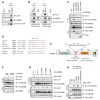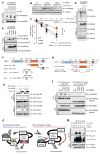Acetylation-dependent regulation of MDM2 E3 ligase activity dictates its oncogenic function
- PMID: 28196907
- PMCID: PMC5468793
- DOI: 10.1126/scisignal.aai8026
Acetylation-dependent regulation of MDM2 E3 ligase activity dictates its oncogenic function
Abstract
Abnormal activation of the oncogenic E3 ubiquitin ligase murine double minute 2 (MDM2) is frequently observed in human cancers. By ubiquitinating the tumor suppressor p53 protein, which leads to its proteasome-mediated destruction, MDM2 limits the tumor-suppressing activity of p53. On the other hand, by ubiquitinating itself, MDM2 targets itself for destruction and promotes the p53 tumor suppressor pathway, a process that can be antagonized by the deubiquitinase herpesvirus-associated ubiquitin-specific protease (HAUSP). We investigated the regulation of MDM2 substrate specificity and found that acetyltransferase p300-mediated acetylation and stabilization of MDM2 are molecular switches that block self-ubiquitination, thereby shifting its E3 ligase activity toward p53. In vitro and in cancer cell lines, p300-mediated acetylation of MDM2 on Lys182 and Lys185 enabled HAUSP to bind, presumably deubiquitinate, and stabilize MDM2. This acetylation within the nuclear localization signal domain decreased its interaction with the acidic domain, subsequently increased the interaction between the acidic domain and RING domain in MDM2, enabled the binding of HAUSP to the acidic domain in MDM2, and shifted MDM2 activity from autoubiquitination to p53 ubiquitination. However, upon genotoxic stress through exposure to etoposide, the deacetylase sirtuin 1 (SIRT1) deacetylated MDM2 at Lys182 and Lys185, thereby promoting self-ubiquitination and less ubiquitination and subsequent degradation of p53, thus increasing p53-dependent apoptosis. Therefore, this study indicates that dynamic acetylation is a molecular switch in the regulation of MDM2 substrate specificity, revealing further insight into the posttranslational regulation of the MDM2/p53 cell survival axis.
Copyright © 2017, American Association for the Advancement of Science.
Conflict of interest statement
Figures





Similar articles
-
Acidic domain is indispensable for MDM2 to negatively regulate the acetylation of p53.Biochem Biophys Res Commun. 2008 Sep 26;374(3):437-41. doi: 10.1016/j.bbrc.2008.07.038. Epub 2008 Jul 16. Biochem Biophys Res Commun. 2008. PMID: 18638452
-
HAUSP-nucleolin interaction is regulated by p53-Mdm2 complex in response to DNA damage response.Sci Rep. 2015 Aug 4;5:12793. doi: 10.1038/srep12793. Sci Rep. 2015. PMID: 26238070 Free PMC article.
-
HLA-B-associated transcript 3 (Bat3) stabilizes and activates p53 in a HAUSP-dependent manner.J Mol Cell Biol. 2020 Feb 20;12(2):99-112. doi: 10.1093/jmcb/mjz102. J Mol Cell Biol. 2020. PMID: 31647545 Free PMC article.
-
Dynamics in the p53-Mdm2 ubiquitination pathway.Cell Cycle. 2004 Jul;3(7):895-9. Epub 2004 Jul 2. Cell Cycle. 2004. PMID: 15254415 Review.
-
ATM-mediated phosphorylations inhibit Mdmx/Mdm2 stabilization by HAUSP in favor of p53 activation.Cell Cycle. 2005 Sep;4(9):1166-70. doi: 10.4161/cc.4.9.1981. Epub 2005 Sep 29. Cell Cycle. 2005. PMID: 16082221 Review.
Cited by
-
Interplay between protein acetylation and ubiquitination controls MCL1 protein stability.Cell Rep. 2021 Nov 9;37(6):109988. doi: 10.1016/j.celrep.2021.109988. Cell Rep. 2021. PMID: 34758305 Free PMC article.
-
The roles and regulation of MDM2 and MDMX: it is not just about p53.Genes Dev. 2021 May 1;35(9-10):575-601. doi: 10.1101/gad.347872.120. Epub 2021 Apr 22. Genes Dev. 2021. PMID: 33888565 Free PMC article. Review.
-
HDAC6 Modulates Signaling Pathways Relevant to Synaptic Biology and Neuronal Differentiation in Human Stem-Cell-Derived Neurons.Int J Mol Sci. 2019 Mar 31;20(7):1605. doi: 10.3390/ijms20071605. Int J Mol Sci. 2019. PMID: 30935091 Free PMC article. Review.
-
Cross-talk between Myc and p53 in B-cell lymphomas.Chronic Dis Transl Med. 2019 Oct 22;5(3):139-154. doi: 10.1016/j.cdtm.2019.08.001. eCollection 2019 Sep. Chronic Dis Transl Med. 2019. PMID: 31891126 Free PMC article.
-
MetaDegron: multimodal feature-integrated protein language model for predicting E3 ligase targeted degrons.Brief Bioinform. 2024 Sep 23;25(6):bbae519. doi: 10.1093/bib/bbae519. Brief Bioinform. 2024. PMID: 39431517 Free PMC article.
References
Publication types
MeSH terms
Substances
Grants and funding
LinkOut - more resources
Full Text Sources
Other Literature Sources
Molecular Biology Databases
Research Materials
Miscellaneous

